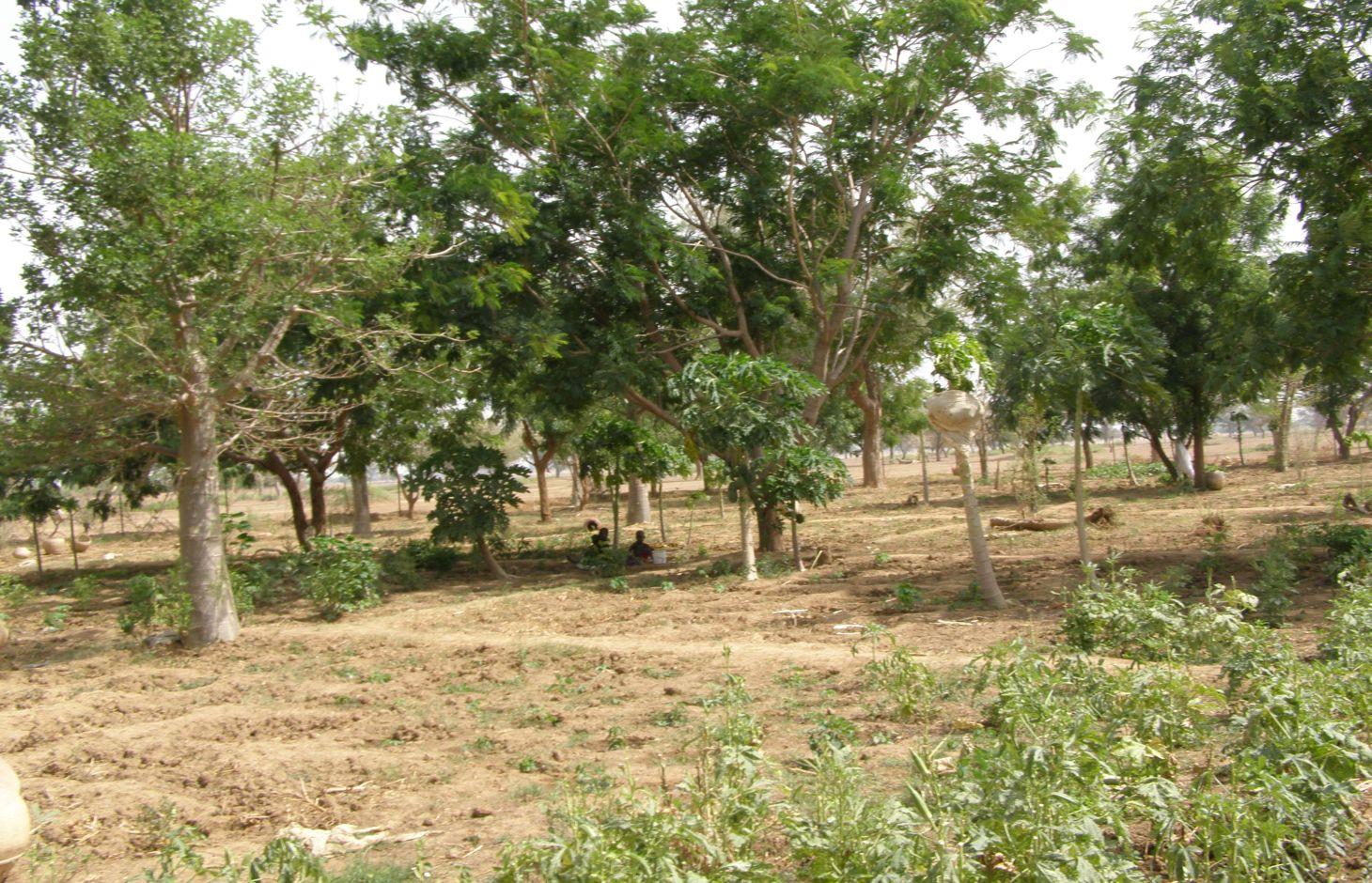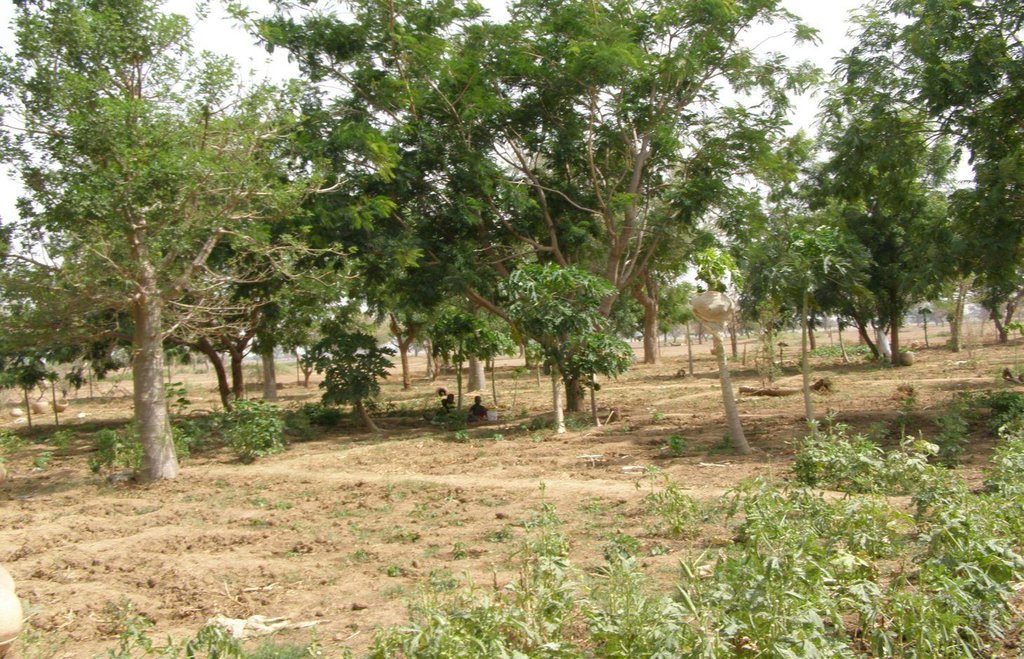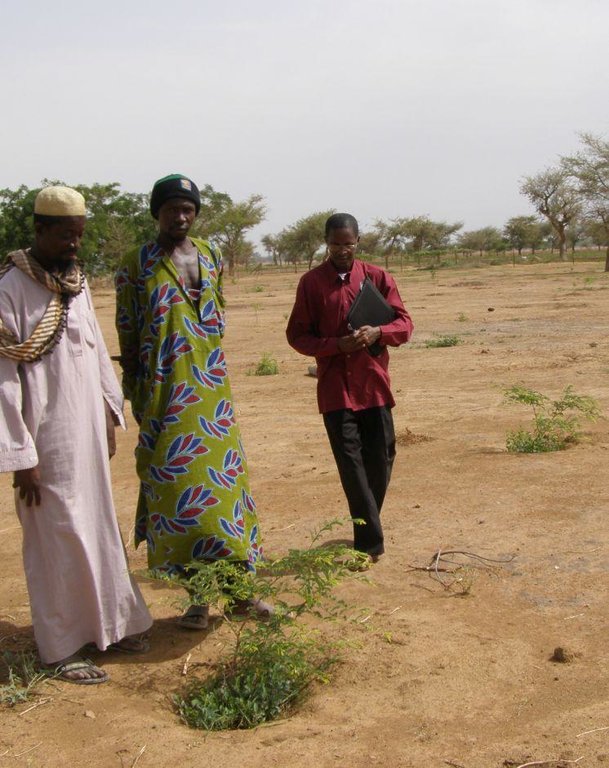Combining agroforestry and gardening to rehabilitate barren lands: the case of the Benkadi cooperative of Syn village [Mali]
- Creation:
- Update:
- Compiler: Dieter Nill
- Editor: –
- Reviewers: Deborah Niggli, Alexandra Gavilano
Combinaison de l’agroforesterie et du maraichage pour réhabiliter des terres dénudées (French)
technologies_1638 - Mali
View sections
Expand all Collapse all1. General information
1.2 Contact details of resource persons and institutions involved in the assessment and documentation of the Technology
SLM specialist:
Coulibaly Bakary Sékou
International Fund for Agricultural Development (IFAD)
Mali
SLM specialist:
Nadio Mamadou
National Coordinator for IFAD Programmes in Mali (CNPPF)
Mali
Name of project which facilitated the documentation/ evaluation of the Technology (if relevant)
Good Practices in Soil and Water Conservation - A contribution to adaptation and farmers ́ resilience towards climate change in the Sahel (GIZ)Name of the institution(s) which facilitated the documentation/ evaluation of the Technology (if relevant)
Deutsche Gesellschaft für Internationale Zusammenarbeit (GIZ) - Germany1.3 Conditions regarding the use of data documented through WOCAT
The compiler and key resource person(s) accept the conditions regarding the use of data documented through WOCAT:
Yes
1.4 Declaration on sustainability of the described Technology
Is the Technology described here problematic with regard to land degradation, so that it cannot be declared a sustainable land management technology?
No
2. Description of the SLM Technology
2.1 Short description of the Technology
Definition of the Technology:
Through the installation of an irrigation scheme for market gardening combined with agroforesty, women’s production of trees and vegetables increases and infertile lands are restored.
2.2 Detailed description of the Technology
Description:
An irrigation scheme for market gardening is installed on barren lands and agroforestry tree species are planted. The aim is to restore degraded lands by planting endemic trees like the baobab and néré, whose leaves and fruit are very commonly used for food and medicinal purposes.
The main objective of this activity is to improve women’s production of trees and vegetables, while ensuring infertile lands are restored. Market gardening also contributes to (i) raising farmers’ incomes through the production of peppers, okra and shallots, (ii) developing the shallot sector, and (iii) building farmers’ capacities.
The plot measures 100 by 100 metres. The planted and living species are: 60 baobab saplings (Adansonia digita), 120 papaya saplings (Carica papaya), 43 néré saplings (Parkia biglobosa), 26 lemon tree saplings (Citrus lemon), 2 tamarind tree saplings (Tamarindus indica), 21 grafted jujube saplings (Zizyphus sp). The vegetable beds are created in between the lines of trees. The vegetable growing site measures 105 by 100 metres (an area of 10,544 square metres). It is provided with farm equipment and machinery, including wells, distribution basins and wire fencing around the entire perimeter. It also contains: 9 Acacia albida saplings, 156 baobab saplings and 78 papaya saplings.
The vegetable growing season runs all year round and is divided into three crop productions. During the cold season from October to March, shallots are planted; in the hot season from March to June, okra is grown; and in the rainy season peppers are grown. Women work 100% of the site. There is a 90% adoption of the growing calendar. Okra and peppers benefit from fertiliser inputs and the techniques used for growing shallots.
Critical issues requiring attention are women’s poor access to the developed land and the scarcity of equipment, particularly for processing okra and shallots.
Located in the urban commune of Djenné, the ‘Benkadi’ cooperative was a beneficiary of SADeF funding in 2009/2010 (for its micro-project to develop a one-hectare market garden scheme). This cooperative was the product of the transformation of Syn women’s collective, which undertakes individual and collective activities, and focuses on the sustainable management of natural
resources. It was set up on 22 May 1998 and its headquarters are located in Syn. More than 130 women aged between 18 and 50 make up the cooperative, and nearly 30 cooperative members work the site. The main collective activities undertaken by the Syn-based ‘Benkadi’ cooperative company are: farming a biodiverse market garden plantation; operating a market garden; implementing a tontine (investment plan); fattening up livestock; growing ground nuts and tree growing; handicrafts. Concerns exist regarding enlarging and enhancing the site’s dewatering system to improve women’s accessibility to the developed land. Members are willing to provide at least 30 women to work the site each day.
SADeF’s installation of the market garden has enabled more than 100 women to take part in income-generating activities. The women have produced and traded: 20,069 kilograms of shallots per year; 150 x 100-kilogram sacks of peppers per year; 429 sacks of dry baobab leaves; 6,090 papaya fruits; 15,700 kilograms of okra. The output from the 2011 growing season made a profit of 12,242,620 CFA francs (23'690 Dollar).
2.3 Photos of the Technology
2.5 Country/ region/ locations where the Technology has been applied and which are covered by this assessment
Country:
Mali
Region/ State/ Province:
Mali
2.6 Date of implementation
If precise year is not known, indicate approximate date:
- less than 10 years ago (recently)
2.7 Introduction of the Technology
Specify how the Technology was introduced:
- through projects/ external interventions
Comments (type of project, etc.):
The ‘Benkadi’ cooperative was a beneficiary of SADeF funding in 2009/2010
3. Classification of the SLM Technology
3.1 Main purpose(s) of the Technology
- improve production
3.2 Current land use type(s) where the Technology is applied
Land use mixed within the same land unit:
Yes
Specify mixed land use (crops/ grazing/ trees):
- Agroforestry

Cropland
- Annual cropping
- Perennial (non-woody) cropping
- Tree and shrub cropping
- okra, pepper
Perennial (non-woody) cropping - Specify crops:
- medicinal, aromatic, pesticidal plants - perennial
Tree and shrub cropping - Specify crops:
- papaya
Number of growing seasons per year:
- 1
Specify:
Longest growing period in days: 120; Longest growing period from month to month: August-November
Comments:
Major land use problems (compiler’s opinion): degraded and bare land
Livestock density: 1-10 LU /km2
3.4 Water supply
Water supply for the land on which the Technology is applied:
- mixed rainfed-irrigated
3.5 SLM group to which the Technology belongs
- forest plantation management
- agroforestry
3.6 SLM measures comprising the Technology

vegetative measures
- V1: Tree and shrub cover
Comments:
Type of vegetative measures: scattered / dispersed
3.7 Main types of land degradation addressed by the Technology

soil erosion by water
- Wt: loss of topsoil/ surface erosion

chemical soil deterioration
- Cn: fertility decline and reduced organic matter content (not caused by erosion)

biological degradation
- Bc: reduction of vegetation cover
- Bs: quality and species composition/ diversity decline
Comments:
Main causes of degradation: crop management (annual, perennial, tree/shrub), droughts, population pressure
3.8 Prevention, reduction, or restoration of land degradation
Specify the goal of the Technology with regard to land degradation:
- restore/ rehabilitate severely degraded land
4. Technical specifications, implementation activities, inputs, and costs
4.1 Technical drawing of the Technology
Technical specifications (related to technical drawing):
Technical knowledge required for field staff / advisors: high
Technical knowledge required for land users: low
Main technical functions: improvement of ground cover, increase in organic matter, increase of biomass (quantity), promotion of vegetation species and varieties (quality, eg palatable fodder), spatial arrangement and diversification of land use
Secondary technical functions: stabilisation of soil (eg by tree roots against land slides), increase / maintain water stored in soil, sediment retention / trapping, sediment harvesting, reduction in wind speed
Scattered / dispersed
Vegetative material: F : fruit trees / shrubs, C : perennial crops
Fruit trees / shrubs species: baobab, papaya, Acacia albida
Perennial crops species: shallots, okra, peppers
4.2 General information regarding the calculation of inputs and costs
other/ national currency (specify):
CFA Franc
If relevant, indicate exchange rate from USD to local currency (e.g. 1 USD = 79.9 Brazilian Real): 1 USD =:
517.0
4.3 Establishment activities
| Activity | Timing (season) | |
|---|---|---|
| 1. | vegetable beds are created in between the lines of trees, provided with farm equipment and machinery, including wells, distribution basins and wire fencing around the entire perimeter | |
| 2. | planting fruit trees and crops/vegetables |
4.4 Costs and inputs needed for establishment
| Specify input | Unit | Quantity | Costs per Unit | Total costs per input | % of costs borne by land users | |
|---|---|---|---|---|---|---|
| Other | Total construction | 1.0 | 35258.0 | 35258.0 | 100.0 | |
| Total costs for establishment of the Technology | 35258.0 | |||||
| Total costs for establishment of the Technology in USD | 68.2 | |||||
4.7 Most important factors affecting the costs
Describe the most determinate factors affecting the costs:
SADeF funded site works to the tune of 18,212,000 CFA francs (35'258 Dollar). The labour contributed by beneficiaries to the installation works is estimated to represent 5% of this, i.e. 910,600 CFA francs. The village authority ceded the site (around a hectare) for the plantation.
5. Natural and human environment
5.1 Climate
Annual rainfall
- < 250 mm
- 251-500 mm
- 501-750 mm
- 751-1,000 mm
- 1,001-1,500 mm
- 1,501-2,000 mm
- 2,001-3,000 mm
- 3,001-4,000 mm
- > 4,000 mm
Agro-climatic zone
- semi-arid
Thermal climate class: tropics
5.2 Topography
Slopes on average:
- flat (0-2%)
- gentle (3-5%)
- moderate (6-10%)
- rolling (11-15%)
- hilly (16-30%)
- steep (31-60%)
- very steep (>60%)
Landforms:
- plateau/plains
- ridges
- mountain slopes
- hill slopes
- footslopes
- valley floors
Altitudinal zone:
- 0-100 m a.s.l.
- 101-500 m a.s.l.
- 501-1,000 m a.s.l.
- 1,001-1,500 m a.s.l.
- 1,501-2,000 m a.s.l.
- 2,001-2,500 m a.s.l.
- 2,501-3,000 m a.s.l.
- 3,001-4,000 m a.s.l.
- > 4,000 m a.s.l.
5.3 Soils
Soil depth on average:
- very shallow (0-20 cm)
- shallow (21-50 cm)
- moderately deep (51-80 cm)
- deep (81-120 cm)
- very deep (> 120 cm)
Soil texture (topsoil):
- medium (loamy, silty)
- fine/ heavy (clay)
Topsoil organic matter:
- medium (1-3%)
- low (<1%)
5.4 Water availability and quality
Ground water table:
5-50 m
Availability of surface water:
medium
Water quality (untreated):
for agricultural use only (irrigation)
5.5 Biodiversity
Species diversity:
- medium
5.6 Characteristics of land users applying the Technology
Market orientation of production system:
- mixed (subsistence/ commercial)
Off-farm income:
- 10-50% of all income
Relative level of wealth:
- poor
- average
Level of mechanization:
- manual work
Gender:
- men
Indicate other relevant characteristics of the land users:
Population density: < 10 persons/km2
Annual population growth: 2% - 3%
10% of the land users are rich.
50% of the land users are average wealthy.
30% of the land users are poor.
10% of the land users are very poor.
5.7 Average area of land used by land users applying the Technology
- < 0.5 ha
- 0.5-1 ha
- 1-2 ha
- 2-5 ha
- 5-15 ha
- 15-50 ha
- 50-100 ha
- 100-500 ha
- 500-1,000 ha
- 1,000-10,000 ha
- > 10,000 ha
Is this considered small-, medium- or large-scale (referring to local context)?
- small-scale
5.8 Land ownership, land use rights, and water use rights
Comments:
The irrigated land is allocated by the chief
5.9 Access to services and infrastructure
health:
- poor
- moderate
- good
education:
- poor
- moderate
- good
technical assistance:
- poor
- moderate
- good
employment (e.g. off-farm):
- poor
- moderate
- good
markets:
- poor
- moderate
- good
energy:
- poor
- moderate
- good
roads and transport:
- poor
- moderate
- good
drinking water and sanitation:
- poor
- moderate
- good
financial services:
- poor
- moderate
- good
6. Impacts and concluding statements
6.1 On-site impacts the Technology has shown
Socio-economic impacts
Production
crop production
product diversity
Income and costs
farm income
diversity of income sources
Socio-cultural impacts
food security/ self-sufficiency
conflict mitigation
situation of socially and economically disadvantaged groups
Contribution to human well-being
Comments/ specify:
SADeF’s installation of the market garden has enabled more than 100 women to take part in income-generating activities. Infertile lands are restored and farmers’ incomes are raised through the production of peppers, okra and shallots.
Ecological impacts
Water cycle/ runoff
surface runoff
Soil
soil moisture
soil cover
soil loss
soil crusting/ sealing
nutrient cycling/ recharge
soil organic matter/ below ground C
Biodiversity: vegetation, animals
biomass/ above ground C
plant diversity
habitat diversity
Climate and disaster risk reduction
wind velocity
6.2 Off-site impacts the Technology has shown
downstream flooding
downstream siltation
wind transported sediments
6.3 Exposure and sensitivity of the Technology to gradual climate change and climate-related extremes/ disasters (as perceived by land users)
Gradual climate change
Gradual climate change
| Season | increase or decrease | How does the Technology cope with it? | |
|---|---|---|---|
| annual temperature | increase | well |
Climate-related extremes (disasters)
Meteorological disasters
| How does the Technology cope with it? | |
|---|---|
| local rainstorm | well |
| local windstorm | well |
Climatological disasters
| How does the Technology cope with it? | |
|---|---|
| drought | well |
Hydrological disasters
| How does the Technology cope with it? | |
|---|---|
| general (river) flood | well |
Other climate-related consequences
Other climate-related consequences
| How does the Technology cope with it? | |
|---|---|
| reduced growing period | well |
6.4 Cost-benefit analysis
How do the benefits compare with the establishment costs (from land users’ perspective)?
Short-term returns:
positive
Long-term returns:
very positive
How do the benefits compare with the maintenance/ recurrent costs (from land users' perspective)?
Short-term returns:
very positive
Long-term returns:
very positive
6.7 Strengths/ advantages/ opportunities of the Technology
| Strengths/ advantages/ opportunities in the compiler’s or other key resource person’s view |
|---|
| improves women’s production of trees and vegetables and restores degraded lands by planting endemic trees like the baobab and néré, whose leaves and fruit are very commonly used for food and medicinal purposes |
| Market gardening also contributes to raising farmers’ incomes through the production of peppers, okra and shallots; developing the shallot sector; and building farmers’ capacities |
| SADeF’s installation of the market garden has enabled more than 100 women to take part in income-generating activities |
6.8 Weaknesses/ disadvantages/ risks of the Technology and ways of overcoming them
| Weaknesses/ disadvantages/ risks in the compiler’s or other key resource person’s view | How can they be overcome? |
|---|---|
| Critical issues requiring attention are women’s poor access to the developed land and the scarcity of equipment, particularly for processing okra and shallots. |
7. References and links
7.1 Methods/ sources of information
- field visits, field surveys
- interviews with land users
When were the data compiled (in the field)?
01/07/2012
7.2 References to available publications
Title, author, year, ISBN:
Manual of Good Practices in Small Scale Irrigation in the Sahel. Experiences from Mali. Published by GIZ in 2014.
Available from where? Costs?
http://star-www.giz.de/starweb/giz/pub/servlet.starweb
Title, author, year, ISBN:
Plan d’affaires du micro-projet de maraîchage de la Société Coopérative “Benkadi” de Syn [Business plan for the market gardening micro-project of the ‘Benkadi’ Cooperative Company in Syn], Djenné Commune, GADC, July 2011
Links and modules
Expand all Collapse allLinks
No links
Modules
No modules






